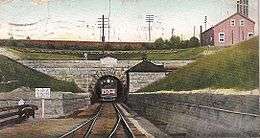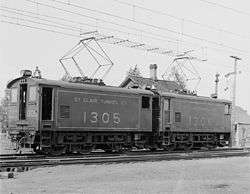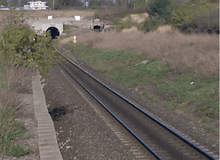St. Clair Tunnel
The St. Clair Tunnel is the name for two separate rail tunnels which were built under the St. Clair River between Sarnia, Ontario and Port Huron, Michigan. The original, opened in 1891 and used until it was replaced by a new larger tunnel in 1995, was the first full-size subaqueous tunnel built in North America.[3] (By full-size it is meant that it allowed a railroad to run through it.) It is a National Historic Landmark of the United States, and has been designated a civil engineering landmark by both US and Canadian engineering bodies.
 View of the original tunnel (closed in 1994) from a 1907 postcard | |
| Overview | |
|---|---|
| Official name | Paul M. Tellier Tunnel (second tunnel) |
| Location | St. Clair River between Port Huron, Michigan and Sarnia, Ontario |
| Coordinates | 42°57′30″N 82°24′38″W |
| Operation | |
| Opened | 1891 (first tunnel) 1994 (second tunnel) |
| Closed | 1994 (first tunnel) |
| Operator | Canadian National Railway |
| Technical | |
| Length | 6,025 feet (1,836 m) (first tunnel) 6,129 feet (1,868 m) (second tunnel) |
| No. of tracks | Single (each tunnel) |
 | |
| Designated | October 15, 1970[1] |
| Reference no. | 70000684 |
| Designated | April 19, 1993[2] |
| Built | 1889 |
| Architect | Beach, Alfred; Hobson, Joseph |
| Governing body | Private |
First tunnel (1891-1995)
The first underwater rail tunnel in North America[4] was opened by the St. Clair Tunnel Company in 1891. The company was a subsidiary of the Grand Trunk Railway (GTR), which used the new route to connect with its subsidiary Chicago and Grand Trunk Railway, predecessor to the Grand Trunk Western Railroad (GTW). Before the tunnel's construction, Grand Trunk was forced to use time-consuming rail ferries to transfer cargo.
The tunnel was an engineering marvel in its day and designed by Joseph Hobson.[5] The development of original techniques were achieved for excavating in a compressed air environment. The Beach tunnelling shield, designed by Alfred Ely Beach, was used to assist workmen in removing material from the route of the tunnel and left a continuous iron tube nearly 7,000 feet (2,100 m) long.[6] Freight trains used the tunnel initially with the first passenger trains using it in 1892.
The tunnel measured 6,025 feet (1,836 m) from portal to portal. The actual width of the St. Clair River at this crossing is only 2,290 feet (698 m). The tube had a diameter of 19 feet 10 inches (6.05 m) and hosted a single standard gauge track. It was built at a cost of $2.7 million.
Locomotives

Steam locomotives were used in the early years to pull trains through the tunnel, however concerns about the potential dangers of suffocation should a train stall in the tunnel led to the installation of catenary wires for electric-powered locomotives by 1907. The first use of electric locomotives through the tunnel in regular service occurred on May 17, 1908.[7] The locomotives were built by Baldwin-Westinghouse.[8]
In 1923, the GTR was nationalized by Canada's federal government, which then merged the bankrupt railway into the recently formed Canadian National Railway. CN also assumed control of Grand Trunk Western as a subsidiary and the tunnel company and continued operations much as before.
The electric-powered locomotives were retired in 1958 and scrapped in 1959 after CN retired and scrapped its last steam-powered locomotives on trains passing through the tunnel. New diesel-powered locomotives did not cause the same problems with air quality in this relatively short tunnel.
Freight cars
After the Second World War, railways in North America started to see the dimensions of freight cars increase. Canadian National (identified as CN after 1960) was forced to rely upon rail ferries to carry freight cars, such as hicube boxcars, automobile carriers, certain intermodal cars and chemical tankers, which exceeded the limits of the tunnel's dimensions.
The tunnel was designated a Civil Engineering Landmark by both the Canadian and the American Societies of Civil Engineers in 1991.[3]
The tunnel was declared a U.S. National Historic Landmark in 1993.[2][3]
Second tunnel (1995-present)

The second tunnel was built to handle intermodal rail cars with double-stacked shipping containers, which could not fit through the original tunnel or the Michigan Central Railway Tunnel in Detroit.[4] By the early 1990s, CN had commissioned engineering studies for a replacement tunnel to be built adjacent to the existing St. Clair River tunnel. In 1992, new CN president Paul Tellier foresaw that CN would increase its traffic in the Toronto–Chicago corridor. The Canada-U.S. Free Trade Agreement was implemented in 1989 and discussions for a North American Free Trade Agreement between Canada, the United States and Mexico discussions were underway at that time (NAFTA was implemented in 1994). It was only logical that import/export traffic on CN's corridor would increase dramatically.
In 1993, CN began construction of the newer and larger tunnel. Tellier declared at the ceremonies:
"[the] tunnel will give CN the efficiencies it needs to become a strong competitive force in North American transportation"
Unlike the first tunnel, which was hand dug from both ends, an earth boring machine called the Excalibore made by the Lovat Tunnel Equipment Inc. was used. It started on the Canadian side and dug its way to the U.S.
The tunnel opened later in 1994 whereupon freight and passenger trains stopped using the adjacent original tunnel, whose bore was sealed. The new tunnel was dedicated on May 5, 1995 and measures 6,129 feet (1,868 m) from portal to portal with a bore diameter of 27 feet 6 inches (8.38 m) with a single standard gauge track. It could accommodate all freight cars currently in service in North America, thus the rail ferries were also retired in 1994 at the time of the tunnel's completion and opening for service.
On November 30, 2004, CN announced that the new St. Clair River tunnel would be named the Paul M. Tellier Tunnel in honour of the company's retired president, Paul Tellier, who foresaw the impact the tunnel would have on CN's eastern freight corridor. A sign now hangs over each tunnel portal with this name.
Incident
On June 28, 2019, train CN M383-28, hauling 100+ cars, had 40 cars derail in the tunnel, spilling 13,700 gallons of sulfuric acid and closing the tunnel for several days afterwards.[9] The tunnel re-opened on July 10, 2019.[10]
See also
- List of National Historic Landmarks in Michigan
- National Register of Historic Places listings in St. Clair County, Michigan
- Port Huron station
- Blue Water Bridge, a nearby international highway bridge
References
- "National Register Information System". National Register of Historic Places. National Park Service. January 23, 2007.
- "St. Clair River Tunnel". National Historic Landmark summary listing. National Park Service. Archived from the original on 2011-06-06. Retrieved 2008-05-02.
- Robie S. Lange (February 1993). "National Register of Historic Places Inventory-Nomination: St. Clair River Tunnel / St. Clair Railroad Tunnel" (pdf). National Park Service. Cite journal requires
|journal=(help) (includes diagrams) and Accompanying two photos, from 1992 (32 KB) - "Chapter 4: The Watery Boundary". United Divide: A Linear Portrait of the USA/Canada Border. The Center for Land Use Interpretation. Winter 2015.
- Kane, Anzovin & Podell 1997, p. 232.
- "The St Clair Tunnel". Hardware. 7 Mar 1890. Retrieved 19 April 2013.
- "Significant dates in Canadian railway history". Colin Churcher's Railway Pages. 2006-03-17. Archived from the original on 2007-08-09. Retrieved 2006-05-17.
- American Railway Association, (Division V - Mechanical) (1922). Wright, Roy V.; Winter, Charles (eds.). Locomotive Cyclopedia of American Practice (6th ed.). New York, NY: Simmons-Boardman Publishing. p. 923. OCLC 6201422.
- 40 train cars derail in international St. Clair River Tunnel spilling 13.7K gallons of sulfuric acid WXYZ-TV, June 28, 2019
- Train tunnel between Michigan and Canada reopens after derailment spilled sulfuric acid MLive.com, July 10, 2019
Sources
- Hyde, Charles K. (1995). "The St. Clair Tunnel: A Triumph of Canadian Engineering". IA, The Journal of the Society for Industrial Archeology. 21 (1): 47–56. JSTOR 40947144.
- Kane, Joseph Nathan; Anzovin, Steven; Podell, Janet (1997). Famous first facts: a record of first happenings, discoveries, and inventions in American history (Fifth ed.). New York: The H. W. Wilson Company. ISBN 0-8242-0930-3.
The first underwater railroad tunnel to a foreign country was the St. Clair Railway tunnel between Port Huron, MI, and Sarnia, Ontario, Canada, which was opened for freight traffic on September 19, 1891, and for passenger traffic on December 7. The tunnel was designed and built under the supervision of Joseph Hobson, chief engineer of the Grand Trunk Railway (later the Canadian National Railways), at a cost of $2.7 million. Its length from portal to portal was 6,025 feet.
CS1 maint: ref=harv (link)
External links
| Wikimedia Commons has media related to St. Clair River Tunnel. |
- Historic American Engineering Record (HAER) No. MI-67, "St. Clair Tunnel, Under St. Clair River between Port Huron, MI, & Sarnia, ON, Canada, Port Huron, St. Clair County, MI", 16 photos, 64 data pages, 2 photo caption pages
- HAER No. MI-67-A, "Port Huron Pump House, Southwest of west portal", 3 photos, 11 data pages, 2 photo caption pages
- HAER No. MI-67-B, "Sarnia Pump House, Northeast of east portal", 5 photos, 13 data pages, 2 photo caption pages
- 1890-07-26: THE SIMS - EDISON ELECTRIC TORPEDO - THE TORPEDO AT FULL SPEED - SECTIONAL VIEW OF THE TORPEDO
- Pictures of both tunnels
- First International Tunnel Historical Marker at MichMarkers.com

